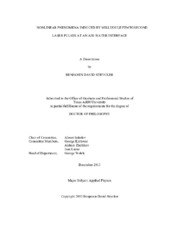| dc.contributor.advisor | Sokolov, Alexei | |
| dc.creator | Strycker, Benjamin | |
| dc.date.accessioned | 2014-05-13T17:23:20Z | |
| dc.date.available | 2014-05-13T17:23:20Z | |
| dc.date.created | 2013-12 | |
| dc.date.issued | 2013-11-04 | |
| dc.date.submitted | December 2013 | |
| dc.identifier.uri | https://hdl.handle.net/1969.1/151778 | |
| dc.description.abstract | Femtosecond laser pulses with millijoule energy have the potential to be used in many applications for remote sensing in marine environments. In this dissertation, we investigate some of the basic phenomena involved when a loosely focused, potentially filament-forming millijoule femtosecond laser pulse propagating in air interacts with an air-water interface.
As an introduction to the primary investigation, we discuss concepts and experiments relevant to the primary investigation: the interaction of millijoule femtosecond laser pulses with an air-water interface. We first discuss linear femtosecond pulse propagation in water and describe an experiment investigating pulse attenuation behavior in water in the linear pulse propagation regime. We find no deviations from exponential attenuation, in contradiction to some earlier works. We then discuss nonlinear pulse propagation in water and describe an experiment investigating the onset of nonlinear pulse propagation and spectral transformation in water. We find that nonlinear femtosecond pulse propagation begins at a peak pulse intensity of about 1010 W/cm2. This experiment provides a convenient segway into the discussion and investigation of femtosecond laser filaments. We describe an experiment in which two filaments interact within liquid methanol and exchange energy. We then discuss laser- induced breakdown spectroscopy and demonstrate that different LIBS signal intensity thresholds can be utilized to image shallowly buried objects.
Finally, all of these concepts are brought together to discuss the interaction of millijoule femtosecond laser pulses with an air-water interface. We catalogue and describe the main phenomena involved, which span about 12 orders of magnitude in time. We then describe the characteristics of the acoustic shockwaves generated by this interaction and demonstrate the usefulness of millijoule femtosecond laser pulses in several remote sensing applications in marine environments. | en |
| dc.format.mimetype | application/pdf | |
| dc.language.iso | en | |
| dc.subject | filaments | en |
| dc.subject | water | en |
| dc.title | Nonlinear Phenomena Induced by Millijoule Femtosecond Laser Pulses at an Air-water Interface | en |
| dc.type | Thesis | en |
| thesis.degree.department | Physics and Astronomy | en |
| thesis.degree.discipline | Applied Physics | en |
| thesis.degree.grantor | Texas A & M University | en |
| thesis.degree.name | Doctor of Philosophy | en |
| thesis.degree.level | Doctoral | en |
| dc.contributor.committeeMember | Kattawar, George | |
| dc.contributor.committeeMember | Zheltikov, Aleksei | |
| dc.contributor.committeeMember | Laane, Jaan | |
| dc.type.material | text | en |
| dc.date.updated | 2014-05-13T17:23:20Z | |


